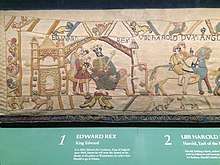Elizabeth Wardle
Elizabeth Wardle (1834–1902)[1] was an English embroideress. In 1857 she married the silk dyer Thomas Wardle, a distant cousin. Thomas was later knighted for his services to the silk industry.
Elizabeth lived in Leek, Staffordshire, where her husband´s business was based. She founded the Leek Embroidery Society and produced a full-scale replica of the Bayeux Tapestry. She died in Leek and is buried in the nearby village of Cheddleton.
Leek Embroidery Society
In 1879, Elizabeth founded the Leek Embroidery Society to promote art embroidery. Leek and its society became one of the leading producers of art embroidery in England, supplying several major department stores.[2] Around 1881, Elizabeth founded the Leek School of Art Embroidery, closely associated with the society.[1]
Elizabeth Wardle developed a form of embroidery using tussar silk (a wild silk). Her husband had recently expanded his business by dyeing the fibre, which he sourced in India. He promoted tussar silk and designed works for the Leek embroiderers. Thomas Wardle imported some tussar silk in woven form, but the embroiders were interested in the dyed yarns, specifically floss which was suitable for embroidery thread.
Art needlework was an expression of the Arts and Crafts movement and Elizabeth has been called a leading practitioner of the art, inspired by the likes of William Morris, with whom she was acquainted.[3] William Morris stayed in the Wardle home in Leek. He was also a designer of several works for the Leek Society.[4]
Bayeux Tapestry replica

The replica was finished in 1886 and is now exhibited in Reading Museum in Reading, Berkshire, England.[5] Elizabeth and Thomas first saw the original tapestry on a visit to Bayeux in 1885 and Elizabeth determined to embroider a replica "so that England should have a copy of its own".
As the original work uses wool, the Leek embroiders avoided the use of their typical fibre, silk. Thomas produced worsted yarns for the project using vegetable rather than chemical dyes. Some 35 members of the Leek Embroidery Society and others helped create the work. The replica was exhibited in several English cities including London where it received a prize, and later was exhibited in South Africa before returning to its then permanent home in Reading.[6] The replica first came to Reading in 1895 and was an early exhibit in the Reading Museum art gallery, opened in 1897.[7]
References
- William Morris (2014) [1984]. Norman Kelvin (ed.). The Collected Letters of William Morris, Volume I: 1848-1880. Princeton University Press. p. 262. ISBN 9780719067006.
- Linda Cluckie (2008). The Rise and Fall of Art Needlework: Its Socio-economic and Cultural Aspects. Arena books. pp. 14, 95–97. ISBN 9780955605574.
- Carola Hicks (2011). The Bayeux Tapestry: The Life Story of a Masterpiece. Random House. p. 182. ISBN 9781407065885.
- Brenda M. King (2005). Silk and Empire. Manchester University Press. pp. 154–155. ISBN 9780719067006.
- "Britain's Bayeux Tapestry at Reading Museum". Retrieved 2018-04-10.
- John F. Szabo; Nicholas E. Kuefler (2015). The Bayeux Tapestry: A Critically Annotated Bibliography. Rowman & Littlefield. p. 412. ISBN 9781442251564.
- "Bayeux Tapestry replica displayed in Reading museum". BBC. 17 January 2018. Retrieved 2018-04-10.
Further reading
- Mitchell, Rosemary (2020). "Wardle, Elizabeth (1834–1902)". Oxford Dictionary of National Biography (online ed.). Oxford University Press. doi:10.1093/ref:odnb/9780198614128.013.93813. (Subscription or UK public library membership required.)